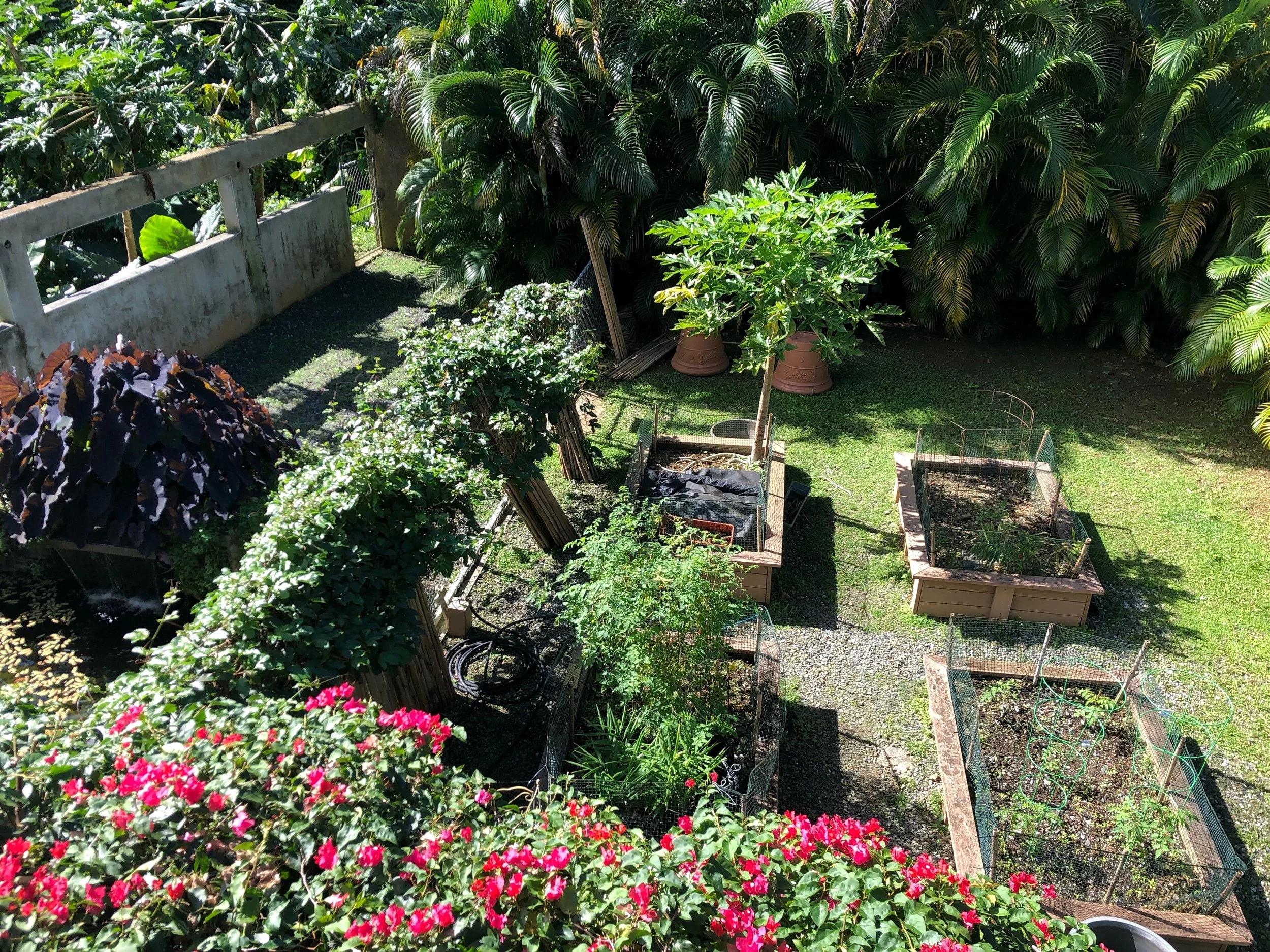The Rainforest Inn’s famous breakfast is made even better by the plethora of fresh fruits and produce grown on the property.
From the micro greens she raises in the kitchen beneath a grow lamp, Renée cultivates leafy, mature greens. After snipping the micro greens for consumption, she places the nearly-translucent roots into fertile soil, which sits in a patch of sunshine just outside the kitchen. From these left-behind roots sprout arugula, kale, and other hearty greens. Beside this sits a pot of New Zealand spinach, which Renée cautions should never be eaten raw if you want to enjoy it…
Situated on a part of the property without canopy overhead sunshine and nutrients bathe the garden consistently. Tomato vines stretch up along their metal cage towards the sky. Renée pulls aside the fronds of an unfamiliar-looking plant to reveal its roots: edible ginger. “I love ginger and have a great ginger crepe recipe that I serve,” Renée explains. A red ginger flower graces one of the plants.
This new, flowering stalk grows from a ginger root.
To see spices and produce typically purchased at grocery stores in the “wild” is tantalizing. I wish there was a ripe papaya to taste, as a small tree grows in the garden and larger ones grow nearby. Yesterday’s “smoothie of the day” featured papaya, so I know the juicy ones got chucked into a blender before I arrived. Still, yellow tinges the base of one green papaya, announcing its impending maturity; I cannot wait to have a try.
A friendly lizard hangs out on a papaya as they wait to get ripe.
Parcha vines grow along the fence separating the garden from Bill and Renée’s private porch. A koi pond, which features its own bio filter filled with mint, spearmint, black magic taro, and watercress, also has a gurgling waterfall. The koi flash and glisten in the sun. The parcha vines dangle a tropical fruit known as parcha in Spanish or, in English, passion fruit.
Don’t miss our updates on upcoming events, new stories, useful tips, new availabilities and last-minute cancellations. We invite you to sign-up now so we are in contact :)
To eat the parcha (passion fruit), you just scoop out the insides!
These little fruits (in the plant world passion fruit is considered a “modified berry” of the family cucurbitaceac) have pulpy interiors that taste of tangy fruit punch, a refreshing snack. Apple-banana trees (locally known as manzanos) grow around the property - unlike the classic banana, these have a flavor more similar to apples. One can also easily find starfruit near the inn’s parking spaces when unloading.
Checking to see how ripe a star fruit is.
Harder to find, a Pomarosa tree flowers alongside the building in construction for the soon-to-be spa, gym, and three-floor private villa Bill refers to as the Treehouse Suite. A single yellow fruit dangles from its branches, as it’s not yet fully in season.
We love our pollinators! This little friend is inside a Pomarosa flower. Next will come the fruit, which resembles tiny yellow apples and smells very floral.
Below, lime, mango, and cacao trees, and pearl mangosteen, intersperse the non-producing foliage. These small tropical fruit trees are planted in a cleared area with jungle nearby. On the terrace overlooking this grows a bed of pineapples surrounded by strawberries and culantro, a wide-leafed cousin of cilantro used in many Puerto Rican dishes like rice and beans. Renée uses the culantro in her breakfast burritos.
Incredible vista beyond the pineapple, strawberry, and culantro bed.
Nearby (below the large main koi pond) you can also find a miracle fruit tree, whose berries change the chemistry of your tongue so that everything you eat afterwards tastes sweet.
Watercress fills the property’s main bio-filter and keeps the large koi pond crystal clear. Nearby, Renée keeps pots of various spices: thyme, rosemary, basil, parsley, and licorice. Edible flowers grow in several pots, as does aloe. Around every corner of the property, something edible grows from the earth. This includes the Strangler Fig tree, whose fruit is enjoyed by birds and bats rather than humans.
Volunteer (intern) Grace smelling the fresh herbs to decide how to season her dinner.
Harvested for flavor and reflective of the Inn’s larger commitment to sustainability and stewardship, all produce is happily shared with guests. From avocado toast topped with baby micro greens to crepes spiced with fresh ginger and smoothies made with just-picked papaya and starfruit, part of experiencing the Puerto Rican rainforest is tasting it.




















